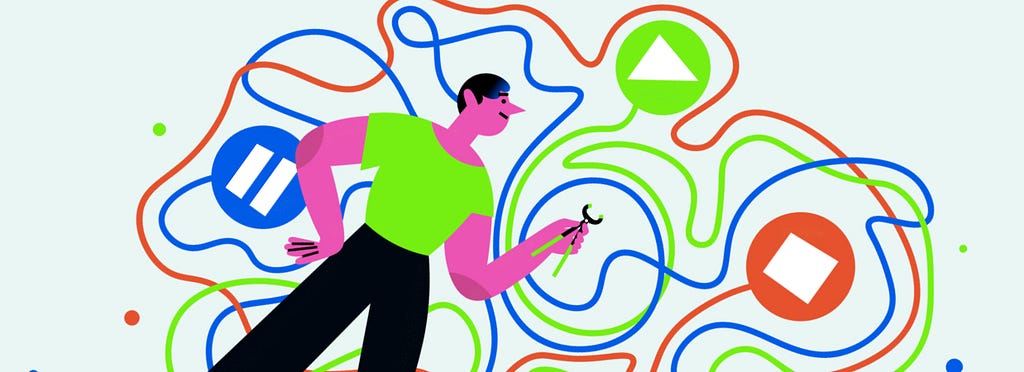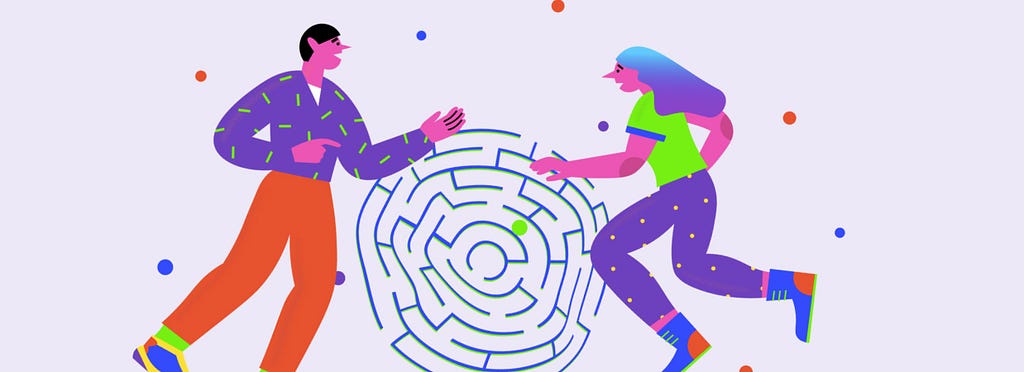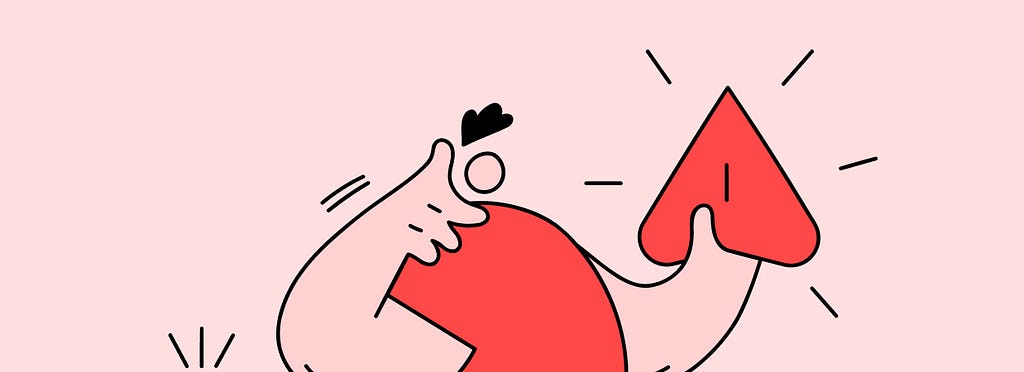
Every time I work with my Product manager it simply feels like trying to paint the Mona Lisa while someone behind you is whispering, “Can it be done in two hours and also make her smile bigger?
Constantly hearing buzzwords like ‘roadmap,’ ‘PRD,’ and ‘KPI’ thrown around can leave me wanting to attach my chair to the coffee machine permanently.
Navigating the World of Product Management as a Designer

The first round of tension starts with the language. Often the PMs use certain words which might feel like the wifi password but actually are pretty easy to understand.
By learning key terminology, you’ll not only grasp what’s being asked of you but also prove that you’re aligned with the project’s progress.
And when unsure, asking, “How does this affect the design?” can save you from a lot of headaches.
Understanding Vision and Strategy

As designers, we focus on delivering visually appealing and user-friendly experiences. Meanwhile, PMs prioritize deadlines, user data, and budgets (I know — how dare they, right?).
It’s okay to push back when their requests clash with quality design, but it’s essential to know when and how to do it.
Here’s how I’ve figured out how to navigate the tension: it all comes down to understanding the product vision and strategy. The biggest source of friction between designers and PMs often occurs when designers are left without a clear long-term direction.
When you, as a designer, have a solid grasp of the bigger picture — like the product’s goals, target users, and long-term roadmap — it not only gives your work purpose but also makes it easier to communicate your design decisions.
You can push back confidently when needed because you’re not just fighting for aesthetics; you’re advocating for a design that fits the broader vision.
When you and your PM are on the same page, you can better explain why certain design choices matter, not just for the immediate release but for the product’s future development.
Putting Users First: The Key to Building Better Products

Being a product manager has its perks — like having an almost psychic connection with your users.
They know exactly what the users need, what they’re thinking, and probably what they had for breakfast.. As a designer, however, it can sometimes feel like you’re working in the dark. Without direct access to this level of user understanding, designing can feel like you’re working with a blindfold on — guessing what users might want instead of knowing it for sure.
This is when I realized how important it is for designers to have at least a basic grasp of product management. Understanding the fundamentals of product management not only makes collaboration smoother, but it also bridges the gap between you and the users.
When you know the product’s goals, the user pain points, and the metrics the product team is tracking, you gain a clearer perspective of why you’re designing something in a certain way.
By familiarizing yourself with the product’s strategy, you start designing with a clear vision and purpose, not just creating something aesthetically pleasing but something that solves real user problems.
Also it saves you from awkward questions like ‘why have you used a pizza cursor for a calorie tracking app.’
Expanding Roles: Designers in Ideation, Research, and Launch

I remember the days when the role of designers in the launch was limited to pushing the feature, collecting feedback and making changes.
But now, come on guys, we live in a world where dark mode is considered a personality trait, 10PM embarks evening and company policies are actually employee friendly.
Designers, once seen primarily as the creatives who made things “look good,” now play a far more integral role in the product development process. And it’s not just about aesthetics anymore; designers can contribute to every phase — from ideation to research — helping shape the product in ways that make it both beautiful and functional.
Traditionally, ideation was dominated by product managers and engineers, but times have changed. Designers bring a unique, user-centered perspective that can elevate the brainstorming process. While PMs are focused on business goals and engineers are thinking about feasibility, designers are the ones who really champion the user experience (UX).
The research phase is where designers really shine. While product managers and marketing teams are analyzing market trends and business needs, designers focus on understanding the user. They dig into what real people want, how they behave, and where they run into frustrations.
Wrangling the Dream Team

Apart from this, Designers who know how to manage a product team, are like the secret sauce that turns a good burger into a great one.
When you understand the product roadmap, business goals, and how to navigate the team’s constant juggling of deadlines, you stop being the “make-it-pretty” person and become a key player in driving product success.
You’re able to prioritize what really matters, like telling the PM, “Yes, we can make the button bigger, but maybe let’s fix the broken user flow first?” It’s about aligning design with the bigger picture — and let’s face it, no one likes pretty designs that users hate using.
Plus, being in the product management loop means fewer surprises and less hair-pulling when last-minute requests come flying in. You know the business constraints, the user needs, and, importantly, you know when to say, “Hey, we need to cut that feature if you want this to launch before the next century.”
It’s not just about creating pretty visuals, but about shaping a product that actually works — and throwing in some design magic to make it all sing!
Metrics Mafia: Not Just for PMs

Why should PM’s have all the fun? Designers can chase metrics too (not just the deadlines). When designers start chasing PM metrics like user retention, conversion, and user satisfaction, they become more than just the “visual wizards” — they’re now the secret agents of product success.
By designing with these key metrics in mind, you’re not just making things look good; you’re directly influencing how users interact with the product. Imagine tweaking a button placement and suddenly seeing a spike in conversions, or streamlining the user journey and watching retention rates soar.
Knowing the metrics means you’re not just guessing what works — you’ve got a data-driven design plan that keeps users hooked and happy.
Plus, by focusing on these metrics, designers become invaluable partners in shaping the product’s direction.
Instead of waiting for PMs to drop a list of requirements, you’re proactively designing for the outcomes that matter — whether it’s improving user satisfaction by creating a smoother onboarding experience or boosting conversion rates with a more intuitive checkout process.
You’re no longer the “art department,” you’re a metric-chasing design powerhouse helping to steer the ship toward measurable success!
I also launched PM 101 Guide for Product Designers:
Aimed at providing you with a competitive advantage.
But hey, don’t just take my word for it. A buddy of mine used this exact blueprint and made his transition to Product Management.
You too can leverage its benefits by clicking the link below 👇🏼
Product Management 101 for Product Designers with Shai Krish
Summing up
Now you know that your impact goes way beyond picking colors or resizing buttons. By leveling up your product management skills, you can make the whole process smoother and easier — not just for yourself, but for everyone sitting at that chaotic, ever-rocking product table.
You’ll be the designer who not only makes things look good but also keeps the whole ship sailing in the right direction!
Cheers! You’re Breathtaking!
Don’t let your PM think you’re Dumb: Designer’s Guide to Product Management was originally published in UX Planet on Medium, where people are continuing the conversation by highlighting and responding to this story.